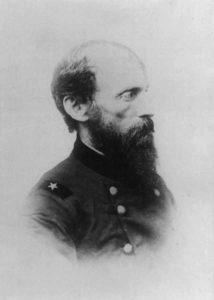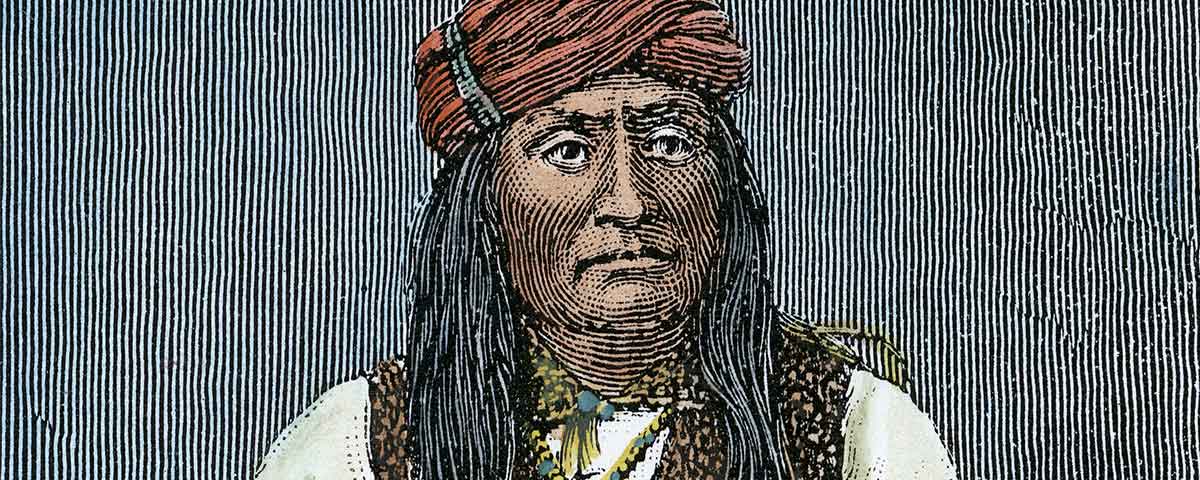The Gruesome Death of the Defiant Warrior Mangas Coloradas
[quote style=”boxed” float=”left”]“Often I have been compelled to ask myself, “Who is the civilized and who is the savage?” –The Rev. William H. Goode, Methodist missionary, 1843[/quote]
Not all of the Union’s enemies wore gray or butternut uniforms and hailed from the South. At the same time Federal forces were fighting pitched battles with the Confederates, they were enmeshed in a bitter conflict against various indigenous tribes for control of the Southwest. None of the tribes was more ferocious than the Chiricahua Apaches, who had long since honed their fighting skills against the Pueblos, Navajos, Pimas, and Papagos, as well as their longtime Mexican enemies.
When U.S. forces began moving into the Southwest during the Mexican War, the Apaches at first saw no cause for alarm. Taking to heart the old adage, “The enemy of my enemy is my friend,” they signed a peace treaty with the Americans. The tribal chief instrumental in structuring the treaty had befriended several American trappers, including the legendary Kit Carson. The chief’s true name (Kan-da-zis-tlishishen) was virtually unpronounceable to all but his fellow Apaches. He had been dubbed “Fuerte” (Strong) by the Mexicans, but he had become known as Mangas Coloradas (Red Sleeves). According to oral tradition, he had acquired the name either as an allusion to the red shirts he favored, or in reference to the blood of slaughtered Mexicans.
Labeled by one historian as the “undisputed Lord of Apacheria,” Mangas was an imposing figure. Standing “considerably over six feet in height,” as one observer wrote, he towered above Anglos, Mexicans, and fellow Apaches alike. A young prospector described the chief when he was about 70—his exact birth year is unknown but likely circa 1793—and just days away from his death: “Mangas was a large athletic man….His shoulders were broad and his chest full, and muscular. He stood erect and his step was proud and altogether he presented quite a model of physical manhood.” In addition to his striking appearance, Mangas was a highly respected leader, a revered warrior and a brilliant strategist.
The U.S.–Apache peace was short-lived, however, as disputes over terms and territory, leading to an unwanted influx of American miners into Apache lands, quickly escalated into violence. The situation was exacerbated by the cultural ignorance of U.S. Army commanders who either did not know or arrogantly chose to ignore the fact that the people they collectively referred to as “Apaches” were, in fact, composed of separate and often-unconnected tribes. Army troops, therefore, attacked peaceful bands, rendering them instantly hostile. As the Apaches fought for both survival and revenge, no other warrior at that time attained the status of Mangas. He united the disparate bands under his leadership, and waged an all-out war against the despised Americans.

Time took its toll on the old chief, however. By 1862, Mangas had had enough of war. Having recently recovered from a serious bullet wound, he was bone-tired. He sent word that he wished to make a lasting peace, and in January 1863—under a peace flag and having received assurances of personal safety from a white scout whom he trusted—he attended a council at Pinos Altos, about 20 miles north of Fort McLane, New Mexico Territory.
Prior to the meeting, a group of soldiers and prospectors had concealed themselves to await the chief’s arrival. At a prearranged signal from the scout, the gang burst from cover, seized Mangas, and conveyed him under heavy guard to Fort McLane. Here, Mangas was turned over to Brig. Gen. Joseph Rodman West. A Louisiana native, West had joined the 1st California Volunteers as a lieutenant shortly after the war broke out and had rapidly been promoted to general’s rank.
Earlier, West’s superior, Brig. Gen. James Henry Carleton, had ordered him to eliminate all male members of Mangas’ band, stating, “[T]he punishment of that band of murderers and robbers must be thorough and sharp.” West was only too willing to comply. When he met Mangas, West informed the old chief that he had “murdered your last white victim, you old scoundrel.” He surreptitiously informed two private soldiers guarding Mangas that, by tomorrow morning, “I want him dead….”
Later that night, the two soldiers tortured the bound Mangas by applying heated bayonets to his legs and feet. The chief defiantly told them that he was not a child to be played with so. At this, the two soldiers rose and fired their muskets point-blank at Mangas, whereupon a sergeant approached and finished him off with a pistol ball to the head.
West blatantly lied in his report to General Carleton, stating that the chief had been killed in an escape attempt, and that “the good faith of the U.S. Military authorities was in no way compromised.” Not surprisingly, the report was accepted as written.
The next day, a soldier scalped the dead chief, and he and his comrades rolled the body into an arroyo, loosely covering it with handfuls of dirt and scrub brush. The U.S. Army, however, was not finished with Mangas.
The regimental physician, Dr. David Sturgeon, soon arrived and ordered the body exhumed, demanding that he be given the chief’s head “for scientific purposes.” Mangas’ head was duly severed, and Sturgeon boiled it in a large kettle until he could extract the skull. This artifact, according to one of the soldiers, “was the wonder of all who saw it….”
Sturgeon later gave the skull to Dr. Orson S. Fowler, a noted phrenologist who believed character could be discerned from the shape of an individual’s skull. Fowler wrote admiringly of Mangas’ skull in his 1873 book, Human Science of Phrenology, and placed it on display—until it disappeared. Rumors persist to this day that Mangas’ skull reposes in one of the many buildings of the Smithsonian Institution in Washington, D.C., although no records support this speculation or even that the Smithsonian had ever received the chief’s skull.
The murder of Mangas enraged the Apaches. Not only had he been betrayed and slain, his body had been desecrated and his head removed, dooming him to walk headless in the afterlife—an unthinkable horror among the Apaches, who believed strongly in leaving even the bodies of their enemies intact. Mangas’ son-in-law, Cochise, who succeeded him as chief of the Chiricahua Apache, was outraged at the old chief’s death, and the leader of the Bedonkohe Apache band, whom the Mexicans had dubbed Geronimo, considered it “the greatest of wrongs.”
Shortly thereafter, an Apache war party attacked an Army patrol near the Rio Grande. The soldiers beat a hasty retreat, leaving their lieutenant and another soldier dead on the field. The Apaches cut off the officer’s head, as the first act in a war of retribution that would last another 25 bloody years.
Looking back years later, the son of Nednhi Apache Chief Juh recalled, “Little did [they] know what they were starting when they mutilated Mangas Coloradas. While there was little mutilation previously, it was nothing compared to what was to follow.”
Ron Soodalter writes from Cold Spring, N.Y.





